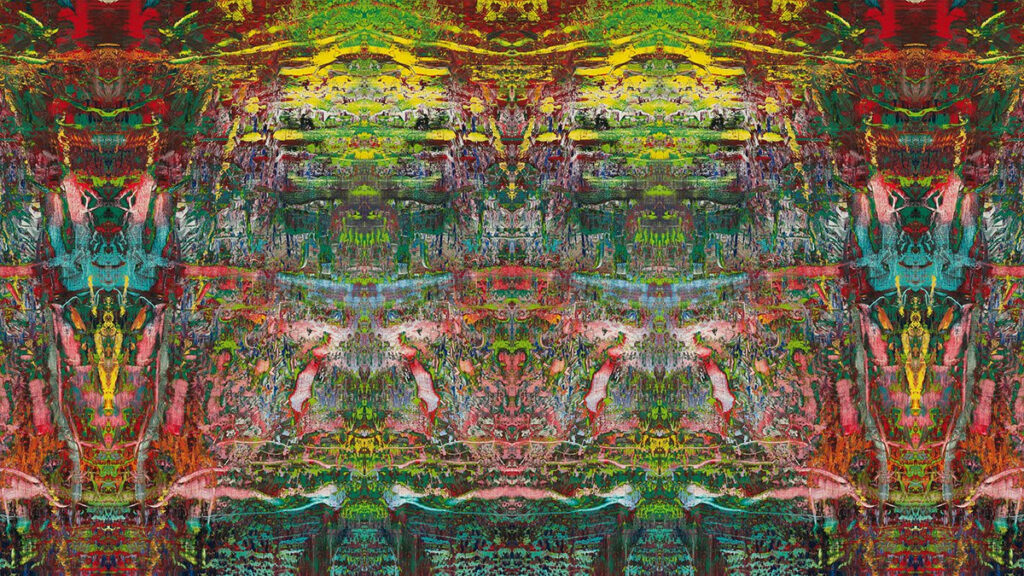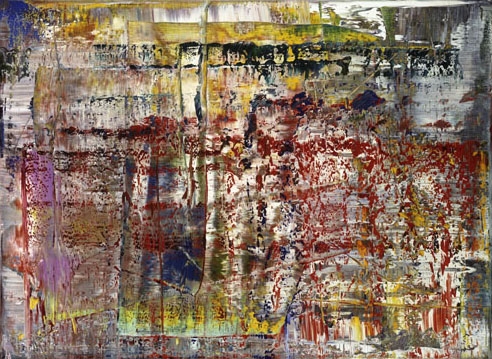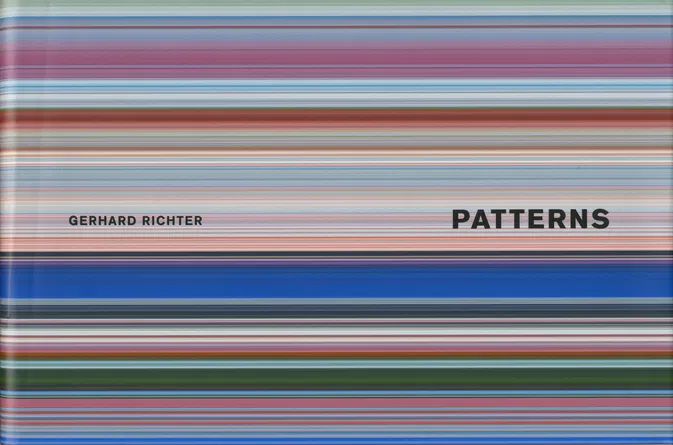
As we try to make sense of wtf happened, and what the future holds, let me try to bring some clarity. As fields and factions drunk on their own importance clamor for dominance, let me try to bring a shared understanding.
So far there have been computer animations based on two Gerhard Richter paintings. They have followed the slicing and mirroring mathematical process of the artist’s Strip series (2009-2013). Richter provided the image to and they were made by filmmaker Corinna Belz. They have been accompanied by music commissioned from multiple composers.
The project having its “gallery debut” next month, which Gagosian Rome is pleased to announce, Moving Picture (946-3) Kyoto Version (2019–24), is of the second painting, Abstraktes Bild (CR 946-3), from 2016. It is, thought, the first to be presented as an immersive installation in film and sound, and the first to be sold, in an edition of eight. What is it, and how did it come to be?
I say “the second painting,” but “the other painting” is probably clearer. Because the best-known Richter video/sound project in NYC/USA, at least—it’s the only one mentioned by Gagosian—is Reich Richter, commissioned by and presented in The Shed in NYC in April 2019. There Ensemble Signal performed Steve Reich’s music live in front of Belz’s animation, which was based on Abstraktes Bild [CR724-4], a 1990 squeegee painting. Richter has used CR724-4 as source material for several editions, four tapestries, one Facsimile Object, all the Strip series works, and the related artist books.

Indeed, it was the artist book Patterns: Divided Mirrored Repeated [CR:149] which served as both the impetus and the blueprint for the videos. The Strip paintings [digital prints under acrylic, but still] mirror and repeat only the narrowest vertical strips of the subject, producing subtly vibrating horizontal stripes called “wallpaper” more than once. Patterns progresses through all the widths, moving from thick, Rorschach-like mirrored blobs, through ever narrower, ever spikier structures, to arrive at the Strip paintings’ microstructure.

Belz’s film, first titled Richters Patterns, follows the arc of the Patterns book, but in reverse. “The film, for which I wrote the music, is basically the Patterns book backwards,” Steve Reich said at The Shed. “It begins with the solid bands of color. These bands are actually each made of only two pixels. As the film progresses the pixel count is multiplied to four, eight, 16, and so on. Eventually the pixel count is diminished, ending, as it began, with two pixels. The music for the film follows that structure.”
But Belz actually started Richters Patterns in 2015, brought into a commission from Kölnmusik between Richter and Ensemble Fabrikmusik for an art/music collaboration. [Richter had joined the board of the contemporary music ensemble and in 2014 began providing his art for the covers of their Editions Fabrikmusik recordings.] The music for Richters Patterns was composed by Marcus Schmickler using a similar mirroring and reversing structure. As with collaborations by the likes of John Cage & Merce Cunningham, music and video were developed separately, and combined for the first time in performance. Richter only saw any of it at the premiere in Sept 2016. “I think he was very surprised and pleased and convinced by the result,” Belz said in 2023. [As an April 2024 presentation in Taiwan tells it, Schmickler “created” the film with Belz, who just used an algorithm on a picture she got from Richter.]
In an interview for the 2023 Lucerne Festival, Belz explained that Richter provided notes and images of a second painting, (CR946-3), in 2017, which became a second film, Moving Picture. Belz explains in 2023 that this was for the Reich Richter commission. But in 2019 Reich and The Shed talked only about the 1990 painting from Patterns the book, and Richters Patterns the movie. [This might explain, though, why Moving Picture was included, with the title Moving Picture (946-3), in Reich/Richter in a 2023 Reich program at SoundStreams in Ontario.]
But Richter had yet another commission, or perhaps request to show a music/art collab that led to a commission. For Moving Picture (946-3) Kyoto Version, Rebecca Saunders made a 37-minute composition for solo trumpet and manipulated sound to be performed by Marco Blaauw at Contact/Connect, a one-week exhibit staged at Kiyomizudera, the mountaintop Buddhist temple complex in Kyoto. The exhibit coincided with the International Council of Museums conference in September 2019. [At the time Moving Picture developed, Blauuw was also collaborating with LaMonte Young, an intriguing context for immersive art/sound experiences.]

[Perhaps in a nod to the impermanence of all things and/or the fact that the unofficial exhibit in a borrowed venue was conceived solely for the attentions of the ICOM attendees and the aggrandizement of its celebrity “curator’s” personal brand, I can find no trace of this exhibit or performance beyond a photo from a later program [pdf] of Blaauw through Richter’s 2012 glass sculpture, 8 Panes, which was also shown. [Saunders does have an epic trailer/excerpt on her site, though.]
A world premiere of the “new version” of the film and the “final version” of the music,” both dated 2019/2020, yet for some reason listed separately, took place in September 2020 at Musikfest Berlin as part of a live music & film program. Both of Belz’s Richter films, Richters Patterns X Schmickler, and Moving Picture (946-3) with Saunders, were performed at the Lucerne Festival in 2023.
Except for the exhibit at Kiyomizudera, where it’s not clear anyone actually saw it, and Reich Richter at The Shed, which was staged as an awkward, two-part, tw0-space performance in a gallery hung with related paintings and tapestries, Richter’s and Belz’s films have been shown as either a concert performance or an accompanied screening. But as all these other performances reveal, the real problem the Gagosian Richter Experience is solving here is not that no one could see Richter’s films; it’s that’s no one could buy them.
Previously: 8,190 Details From A Picture
